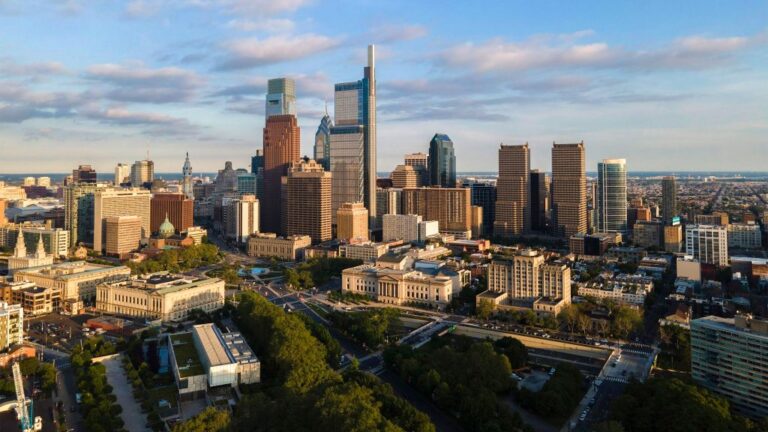How a land value tax could make Philadelphia a more equitable city
By implementing a land value tax, Philadelphia could alleviate tax burdens on its most at-risk populations and help the city’s economy.

The Philadelphia skyline is seen in May 2020. (Mark Henninger/Imagic Digital)
Originally projected to see budgetary gains this year, in the months since COVID-19 began ravaging the northeast — and the rest of the world — Philadelphia’s financial foundations have all but crumbled.
Most major sources of tax revenue, like wages, sales, and amusements are down by as much as 99.8% compared to last year. Not to mention the approved FY21 budget relies on major public sector layoffs and hikes in parking and business taxes to try and close the resulting gap. But even in the midst of this economic meltdown, or perhaps because of it, Philadelphia has the opportunity to make real gains for social and economic justice. How? By simply rethinking its approach to one tax that has proven stable in 2020’s pandemic economy: The real estate tax.
Everyone is familiar with real estate or property taxes. Based on the assessed value of an owner’s buildings and land, real estate taxes have remained in the black since the pandemic began, increasing more than 5% over last July’s total. This is good news, and to those familiar with tax policy, hardly surprising – real estate is a fairly stable, reliable tax base, even when the world is in profound turmoil.
So why would Philadelphia touch its real estate tax now?
Because through a simple mathematical rejiggering of the tax code, Philadelphia could alleviate tax burdens on its most at-risk populations without reducing the overall revenue stream one dime — effectively creating a free stimulus for homeowners and businesses struggling to make ends meet. Philadelphia can create an environment of shared and increased prosperity.
This “rejiggering” involves flipping the proportion of an owner’s tax bill that comes from the value of their buildings, currently 76% — versus the land itself — right now, just 24% of the bill, to one that favors taxing land value.
What difference would this make? Well, as it turns out, a world of difference.
If Philadelphia shifted to just a 50-50 ratio of tax on buildings to tax on land, homeowners would see a savings of over $60M each year, and with land value tax or LVT, that total jumps to about $123M — that’s over 10% less than residential property owners pay now, and in a city where the median household income is less than $48,000 a year, this will have real impact.
Businesses would save, too — just shy of 20% under a full LVT scheme. Of course, to maintain overall revenues, someone has to make up those savings, and here that “someone” is exactly who you’d hope: Land speculators and those who’ve traditionally benefited from tax abatements at others’ expense.
Moving to LVT would be a big step for Philadelphia, and even considering the move prompts a multitude of questions. Pittsburgh and Allentown both have some of the answers, stemming from their own promising experiences in its implementation. The Center for Property Tax Reform has just released a fully interactive map interface — the Tax Shift Explorer — that allows users to explore what a Land Value Tax would mean for the Philadelphia as a whole, as well as each City Council District, and even individual properties, all using real, current tax data as the baseline.
In the time of coronavirus, Philadelphia must meet the competing needs of residents and businesses for public services, as well as for financial relief from taxation. A Land Value Tax can help reconcile these needs and increase economic equity at the same time.
Josie Faass is the executive director of the Robert Schalkenbach Foundation. She holds a Ph.D. in urban planning and public policy from Rutgers University’s Edward J. Bloustein School.

Subscribe to PlanPhilly
WHYY is your source for fact-based, in-depth journalism and information. As a nonprofit organization, we rely on financial support from readers like you. Please give today.







